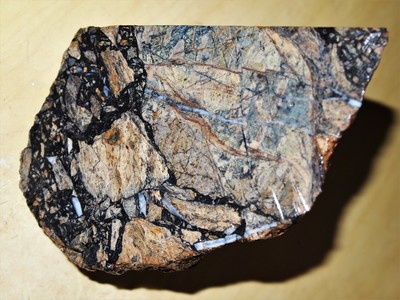As recorded:
New Almaden Mine, New Almaden, New Almaden Mining District, Santa Clara County, California, USA
Collected by:

Photo added to mindat.org
“Breccia, Tertiary Silica-carbonate rock (TSc). Identified visually based on mineralogy, texture, and known locality. TSc is an alteration product of Jurassic-Cretaceous serpentinite (JSp), which, in turn, is an alteration product of a Jurassic ocean plate and upper-mantle rock, which, in general can range from an intermediate basalt to a ultramafic peridotite, with many mafic and ultramafic rocks in between.
Specimen is 5-inches across along top cut face. Cement is finely divided quartz and what appears to be bitumen, a heavy hydrocarbon residual, like asphalt. Small grains of cinnabar are scattered about in the clasts and the matrix. It is easy to see many generations of fracturing, from the earliest iron-stained hairline cracks in the JSp protolith to the thicker bluish-white massive quartz that is filling latest stage fractures. Even these late-stage quartz veinlets are broken up, as one can see pieces of the veins in the breccia. Under the microscope at 30x magnification, one can see scattered tiny blebs of bright red cinnabar in both the clasts and the matrix.
Silica-carbonate rock description compiled from Bailey and Everhart, 1964, USGS Professional Paper 360:
•Derived from serpentine by hydrothermal alteration.
•Composed principally of silica (SiO2) and a carbonate, generally ferroan magnesite (Mg,Fe)CO3).
•In the New Almaden District, chalcedony and opal are so uncommon they can be disregarded in a general description.
•Host rock for the more productive bodies of quicksilver ore. [Cox note: and with higher mean Hg concentration than any other rock types in the mining area.]
•Always restricted to serpentinite bodies, either as replacement rims at the edges or complete replacement where the serpentinite was thin and sheared.
•Pseudomorphic textures inherited from serpentine are typical and recognizable, including the sheared structure of serpentinite
•Typically contains residual unaltered minute crystals of chromite (FeCr2O4) or picotite ((Fe,Mg)(Al,Cr)2O4) [Cox note: International Mineralogical Association rejected name, proper name is Mg- and/or Cr- bearing hercynite (Fe2+Al2O4)].
•Weathering removes ferroan magnesite, leaving only hydrated ferric oxides and silica. [Cox note: blebs of Cr-bearing clay (green) is common weathering artifact.]
•If silica content is low, the rock weathers to an ocherous soil containing only a few siliceous fragments.
•Weathered and ocherous rock often has siliceous skeletons of bastite [(D3[Si2O5](OH)4 D= Mg, Fe, Ni, Mn, Al, Zn) pseudomorphs [serpentine-group minerals after enstatite (Mg2Si2O6)] or vaguely lenticular textures discernible in places, and nearly everywhere the ocher will yield chromite or picotite[Mg/Cr-bearing hercynite] if panned.
[Cox note: the general chemical oxide composition of TSc from this mine does not vary significantly between TSc without cinnabar and TSc with abundant cinnabar. This suggests that the TSc is an older and more regional rock that later served to host very localized hydrothermal fluids that carried cinnabar into the rock, mainly along fractures and with limited replacement of the host rock.]”
Michael Cox - 9th December 2019
No-one has added this to their favourites.
10,443,565 minIDs have been issued as of 27th Apr 2024 2:16 am UTC
